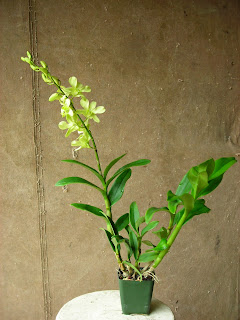
By Jan Wilson
Selecting a pot for your orchid should not be bewildering and a lot depends on the type of orchid you are growing, the location of the plant, the potting mix and how often you need to repot. These days you will notice that many orchid growers use clear plastic pots. This is mainly for examining the root system for pests and diseases, and to check that the potting mix is not becoming too wet, a condition which may start root rot. Quite a few orchids are not terrestrial and in their natural environment their roots are exposed to sunlight. Clear plastic orchid pots can benefit these types of orchid. Experienced orchid growers pot their terrestrial orchid plants in a clear pot and then placed the clear pot inside a normal colored pot. This way they just need to lift the plant out of the outer container to check the orchid's root system.
The most common orchid pots are either terracotta or plastic. Terracotta orchid pots have the advantage of being heavier and stable, especially in outdoor conditions. Plastic containers are often used in the home, but the disadvantage is that the potting mix tends to retain water for longer periods than clay containers. Basket pots are common as well for they enable air circulation around the roots. However, the potting mix in baskets dries out quite quickly.
The orchid species growing requirements are very important when considering the pot. Ludisia orchids require wide, shallow pots as they like to spread across the potting mix surface and they can be successfully grown in glass terrariums. Orchids like Acineta and Gongora, which have pendant flowers, ought to be planted in basket containers. Cymbidium, and other spreading orchids, tend to grow better in larger pots. The Chinese Cymbidium has very long roots and thus a taller pot would suit this plant.










No comments:
Post a Comment